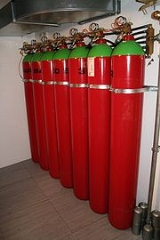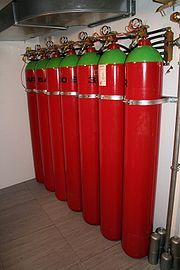
Gaseous fire suppression
Encyclopedia

Inert gas
An inert gas is a non-reactive gas used during chemical synthesis, chemical analysis, or preservation of reactive materials. Inert gases are selected for specific settings for which they are functionally inert since the cost of the gas and the cost of purifying the gas are usually a consideration...
es and chemical agents to extinguish a fire
Fire
Fire is the rapid oxidation of a material in the chemical process of combustion, releasing heat, light, and various reaction products. Slower oxidative processes like rusting or digestion are not included by this definition....
. Also called Clean Agent Fire Suppression. These Agents are governed by the NFPA Standard for Clean Agent Fire Extinguishing Systems - NFPA 2001 in the USA, with different standards and regulations in other parts of the world. The system typically consists of the agent, agent storage containers, agent release valves, fire detectors, fire detection system (wiring control panel, actuation signaling), agent delivery piping, and agent dispersion nozzles.
Less typically, the agent may be delivered by means of solid propellant gas generator
Gas generator
A gas generator usually refers to a device, often similar to a solid rocket or a liquid rocket that burns to produce large volumes of relatively cool gas, instead of maximizing the temperature and specific impulse. The low temperature allows the gas to be put to use more easily in many...
s that produce either inert or chemically active gas.
Theory
There are four means used by the agents to extinguish a fire. They act on the "fire tetrahedron":- Reduction or isolation of fuel
- No agents currently use this as the primary means of fire suppression.
- Reduction of heat
- Representative agents: HFC-227ea (MH227, FM-200), Novec 1230Novec 1230Novec 1230, C6F12O, fluid is an environmentally friendly Halon replacement for use as a gaseous fire suppression agent. Novec 1230 is manufactured by 3M. It is generally used in situations where water from a fire sprinkler would damage expensive equipment or where water-based fire protection is...
, HFC-125 (ECARO-25), FS 49 C2Fire suppression agent FS 49 C2®Fire suppression agent FS 49 C2® is an environmentally engineered, human safe, fast extinguishing Clean Agent fire extinguishing gas for gaseous fire suppression installed in a suited fire suppression system....
.
- Reduction or isolation of oxygen
- Representative agents: ArgoniteArgoniteArgonite is a name brand and registered trademark owned by Ginge-Kerr for a mixture of 50% argon and 50% nitrogen . It is an inert gas used in gaseous fire suppression systems. Ginge-Kerr is part of United Technologies Fire & Security...
/ IG-55 (ProInert), carbon dioxideCarbon dioxideCarbon dioxide is a naturally occurring chemical compound composed of two oxygen atoms covalently bonded to a single carbon atom...
, IG-541 InergenInergenINERGEN is a blend of inert atmospheric gases that contains 52% nitrogen, 40% argon, 8% carbon dioxide, used for fire suppression system agent. It is considered a clean agent for use in gaseous fire suppression applications. Inergen does not contain halocarbons, and has no ozone depletion...
, and IG-100 (NN100).
- Inhibiting the chain reaction of the above components
- Representative agents: FE-13, FE-2271,1,1,2,3,3,3-Heptafluoropropane1,1,1,2,3,3,3-Heptafluoropropane, also called heptafluoropropane, HFC-227 or HFC-227ea , is a colourless, odourless gaseous halocarbon commonly used as a gaseous fire suppression agent.-Chemistry:...
, FE-25, MH227, FM-2001,1,1,2,3,3,3-Heptafluoropropane1,1,1,2,3,3,3-Heptafluoropropane, also called heptafluoropropane, HFC-227 or HFC-227ea , is a colourless, odourless gaseous halocarbon commonly used as a gaseous fire suppression agent.-Chemistry:...
, HalonHaloalkaneThe haloalkanes are a group of chemical compounds derived from alkanes containing one or more halogens. They are a subset of the general class of halocarbons, although the distinction is not often made. Haloalkanes are widely used commercially and, consequently, are known under many chemical and...
s, Halon 1301BromotrifluoromethaneBromotrifluoromethane is an organic halide with the chemical formula CBrF3. Alternative names are Halon 1301, R13B1, Halon 13B1 and BTM.- Table of physical properties :- Uses :...
, Freon 13T1, NAF P-IV, NAF S-III, and Triodide (Trifluoroiodomethane).
Application
Broadly speaking, there are two methods for applying an extinguishing agent: total flooding and local application.Systems working on a total flooding principle apply an extinguishing agent to a three dimensional enclosed space in order to achieve a concentration of the agent (volume percent of the agent in air) adequate to extinguish the fire. These types of systems may be operated automatically by detection and related controls or manually by the operation of a system actuator.
Systems working on a local application principle apply an extinguishing agent directly onto a fire (usually a two dimensional area), or into the three dimensional region immediately surrounding the substance or object on fire. The main difference in local application from total flooding design is the absence of physical barriers enclosing the fire space.
In the context of automatic extinguishing systems, local application normally does not refer to the use of manually operated wheeled or portable fire extinguishers, although the nature of the agent delivery is similar.
Suffocation

Carbon dioxide
Carbon dioxide is a naturally occurring chemical compound composed of two oxygen atoms covalently bonded to a single carbon atom...
, in enclosed spaces present a risk of suffocation. Numerous incidents have occurred where individuals in these spaces have been killed by carbon dioxide agent release. To prevent such occurrences, additional life safety systems are typically installed with a warning alarm that precedes the agent release. The warning, usually an audible and visible alert, advises the immediate evacuation of the enclosed space. After a preset time, the agent starts to discharge. Accidents have also occurred during maintenance of these systems, so proper safety precautions must be taken beforehand.http://www.epa.gov/Ozone/snap/fire/co2/co2report.html
Barotrauma
The positive pressure caused by extinguishant release of the Inert agents in this group (IG-541, IG-55, IG-100) may be sufficient to break windows and walls. Humans and structures must be adequately protected.See also
- Hypoxic air ventingHypoxic air ventingHypoxic air venting is an active fire protection measure that replaces the air within a protected space with inert air that has reduced oxygen concentration. The different concentrations of the components of air are slightly altered; typically, five percent of the oxygen content can be substituted...
- Carbon dioxideCarbon dioxideCarbon dioxide is a naturally occurring chemical compound composed of two oxygen atoms covalently bonded to a single carbon atom...
- Halon 1211BromochlorodifluoromethaneBromochlorodifluoromethane, also known by the trade name Halon 1211, or BCF, or Halon 1211 BCF, or Freon 12B1, is a haloalkane with the chemical formula CF2ClBr....
- Halon 1301BromotrifluoromethaneBromotrifluoromethane is an organic halide with the chemical formula CBrF3. Alternative names are Halon 1301, R13B1, Halon 13B1 and BTM.- Table of physical properties :- Uses :...
- Fire protectionFire protectionFire protection is the study and practice of mitigating the unwanted effects of fires. It involves the study of the behaviour, compartmentalisation, suppression and investigation of fire and its related emergencies, as well as the research and development, production, testing and application of...
- Automatic fire suppressionAutomatic fire suppressionAutomatic fire suppression systems control and extinguish fires without human intervention.According to the National Fire Protection Association, there were 1,602,000 fires reported in the United States in 2005. There were 3,675 civilian deaths, 17,925 civilian injuries, and $9.2 billion in...
- Condensed aerosol fire suppressionCondensed aerosol fire suppressionCondensed aerosol fire suppression is a particle-based form of fire extinction similar to gaseous fire suppression or dry chemical fire extinction. The aerosol employs a fire extinguishing agent consisting of very fine solid particles and gaseous matter to put out fires...
- HFC-227ea

